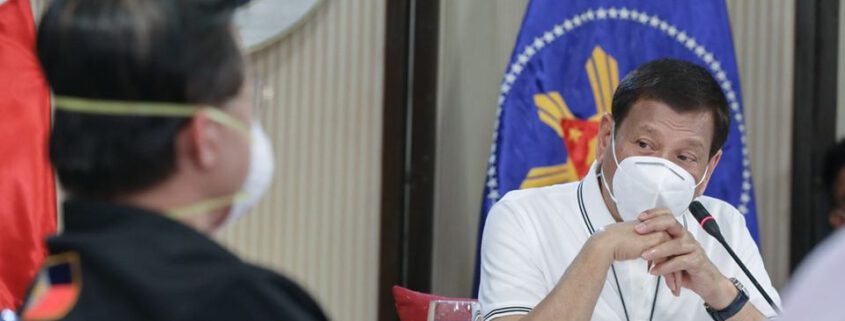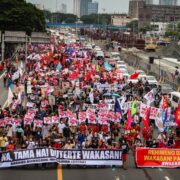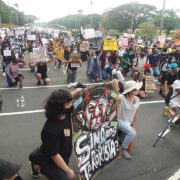Why do we keep on begging China for friendship?
By Rosario Guzman
In the face of the Filipino people’s growing anxieties about COVID-19 and life after the lockdown, president Duterte keeps heaping praises on China.
The Duterte government was reluctant at first to restrict travel and tourism from China and the operations of Chinese Philippine Offshore Gaming Operators (POGOs) because such moves to contain the virus would allegedly hurt China’s feelings. In the next presidential speeches, the government seemed to have flip-flopped from its cavalier attitude towards the pandemic, but it has not stopped uttering assurances to China.
That the Philippines remains to be by China’s side as China battles COVID-19. Or that China will help the Philippines overcome the health crisis and that president Duterte can directly send a personal note to Chinese president Xi Jin Ping. A you-and-me-against-the-world expression of devotion that is repeated ad nauseum.
In the most recent display, returning presidential spokesperson Harry Roque even got a little chummy – referring to the Philippines-China relationship as “BFF” (“best friends forever”), and that naturally China will prioritize the Philippines in giving COVID aid and funds.
It leaves a nasty taste in the mouth as the country continues to grapple with economic uncertainties and government’s lack of direction six weeks into the lockdown.
But is it even valid to cling on to China, or to any other country for that matter, for our survival as a nation post-COVID? Even without COVID-19, it is already insane as it is for the Philippine government to obsessively hold on to failed neoliberal policies and to rely on foreign capital for development. It would take some sobriety to tackle the question, but looking at the global economy and the seismic changes that have been happening is the sensible way to begin.
The world is coming down
China indeed remains the world’s leading merchandise trader and second to the United States (US) in trade of goods and services in the overall. But the slowdown in global trade that has been quite evident since 2016 on the back of a protracted global economic recession is weighing down on the world’s economies and leading traders. This has only been aggravated by the US-China trade war escalating at the end of 2018, which is hurting aggregate import demand, as well as the outbreak of the COVID-19 pandemic emanating from Wuhan, China at the end of 2019 whose impact on world trade is still unfolding.
World merchandise trade volume had a significantly lower growth of 2.9% in 2018 than the 4.6% growth registered in 2017 that raised false hopes of a return to better days. The slowdown in trade was accompanied by weaker output growth – the world gross domestic product (GDP) grew at exactly the same rate as trade (2.9%) compared to a minimally higher growth of 3.0% the year before.
The numbers turned uglier in 2019 – with the combined effects of the trade tensions in the first half clearly felt and the jitters in the second half over the possible lethal spread of COVID-19 across geographic and economic regions. The slowing world merchandise trade finally declined by 0.1% in volume in 2019. Likewise, in dollar values it fell by 3% to US$18.89 trillion, whereas it registered a 10% increase due to higher energy prices just the year before. The global GDP got even weaker with a preliminary growth figure of only 2.6% for 2019.
Projecting the full impact of COVID-19 on trade, the World Trade Organization (WTO) is looking at a further decline in 2020 by 12.9% in an optimistic scenario or by 31.9% in a pessimistic scenario. The International Monetary Fund (IMF) projects the global GDP growth in 2020 to fall to -3%, which is a major revision over a very short period. This crisis is going to be far worse than the global financial crisis, the IMF has said, and the worst since the Great Depression.
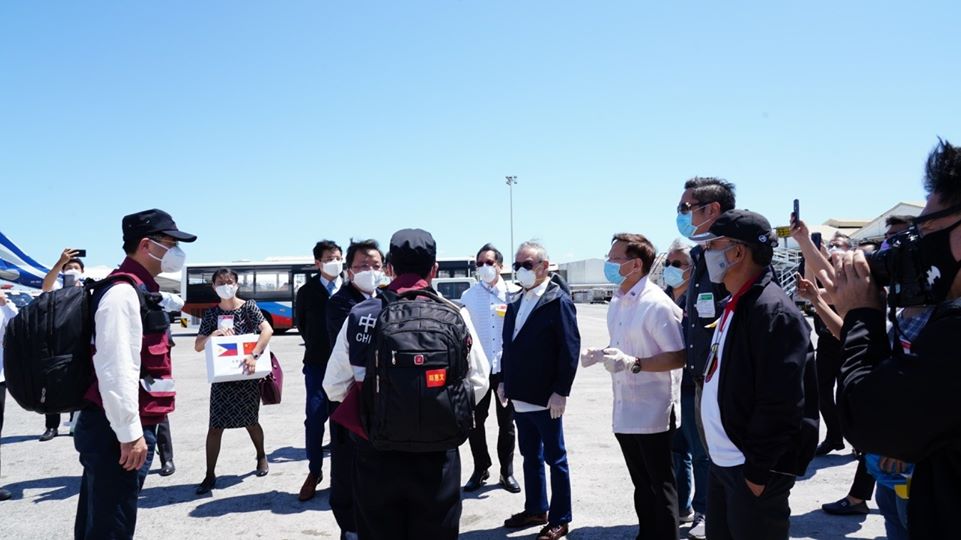
China is symptomatic
The world is watching China with apprehension. The country has high demand for raw materials and intermediate goods and serves as a final-stage export platform for global production chains. But even before the number of COVID cases started climbing at the start of 2020, China’s GDP growth of 6.1% in 2019 was already slower than the 6.7% rate in 2018. It was in fact the country’s slowest growth in 29 years.
The National Bureau of Statistics of China reported a 6.8% year-on-year decline in the first quarter of 2020. It is the first contraction at least since 1992.
China experienced a deceleration in merchandise trade volume, from 8.0% in 2017 to its moderate growth of 5.2% in 2018. The value of exports slowed sharply at 0.5% growth in 2019 from a 10% rise in 2018, while the value of imports fell by 2.7%, the first decline in three years. In the first two months of 2020, exports plunged by 17.2% year-on-year, while imports shrank by 4%, amid factory shutdowns and travel restrictions to contain the virus.
China’s trade surplus and capital formation are its sources of economic strength to rise as an outward investor. In 2018, China ranked 2nd globally, next to Japan, in terms of foreign direct investment (FDI) outflows, and 3rd, next to the US and Netherlands in terms of FDI outward stock. But like global trade and the global economy, global FDI flows were in three consecutive years of decline, falling by another 13% in 2018. China’s FDI outflows slid further by 18%, the second year for China, based on UNCTAD data.
China’s Ministry of Commerce (MOFCOM) reported a lower figure of 9.6% decline in 2018, pointing out that China’s FDI fall was still significantly lower than the world figure of 29% according to MOFCOM. It does not change the general picture, however, no matter how Beijing paints stability. Outward FDI is falling anywhere else in the world, and it is 40% smaller today than its post-global financial crisis peak in 2015.
The China Global Investment Tracker of the American Enterprise Institute, an alternative to MOFCOM data, which tracks Chinese investment and construction around the world with a threshold of US$100 million, is seeing a dramatic fall in China’s outbound FDI of about 40% for 2019 that will be similar to 2011, with Chinese investment returning to a domestic rather than global phenomenon.
The problem is China cannot simply work from home. It has been infected with the unbounded, reckless desire of expansionism – it has to continue going global.
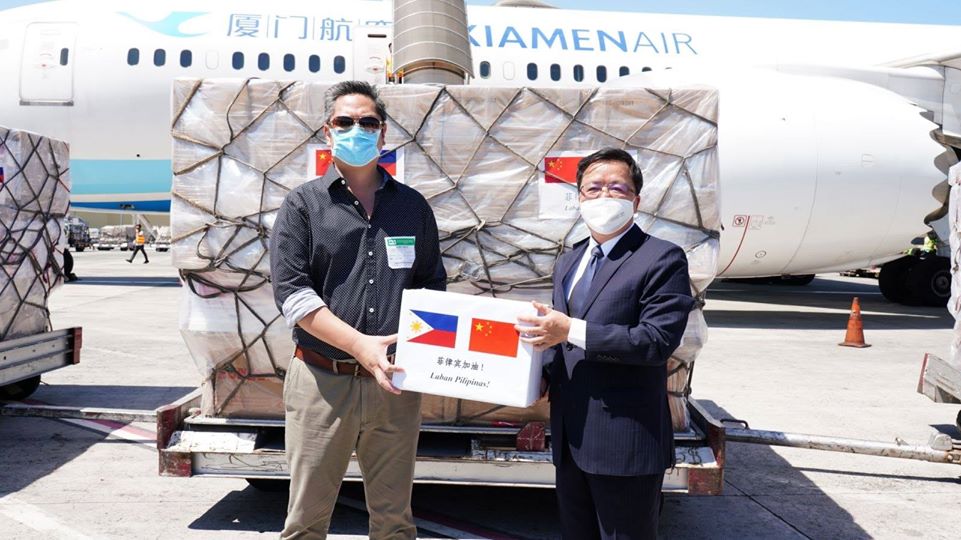
BFF?
The Philippines is not even among the top 15 trading partners of China. It is also not a significant destination of Chinese investment.
Hong Kong (PRC) receives about 60% (US$86.9 billion) of China’s net FDI, followed by the US (US$7.5 billion), Virgin Islands (US$7.1 billion), Singapore (US$6.4 billion), and Cayman Islands (US$5.5 billion). It is obvious how China uses Hong Kong as an intermediary to take advantage of Hong Kong’s liberalized agreements and competitive currency before investing somewhere else, or of “double dipping” wherein Chinese investors return to the mainland as “foreign investors” and take advantage of additional fiscal incentives.
It also appears that Chinese investors, like many global investors, have sought safe havens such as the Virgin Islands and Cayman Islands as times get rough. Removing these and Hong Kong for the meantime would show that the top 10 recipients of China FDI in 2018 were the US, Singapore, Australia, Indonesia, Canada, Germany, Vietnam, South Korea, United Kingdom, and Thailand. The Philippines does not figure anywhere in the line-up.
On the other hand, some 56 countries along the Belt and Road Initiative (BRI), of which the Philippines is part, captured 12.5% of China’s total outward FDI in 2018. BRI investment has been particularly pronounced in the Middle East and North Africa (MENA) region. Meanwhile in Southeast Asia where China’s state-owned enterprises have particular interest, Cambodia is the favorite.
Narrowing our map now to the Association of Southeast Asian Nations (ASEAN), the Philippines captured 11% of China’s investment in the ASEAN in 2019, which is practically a fair share if China’s investment would be divided equally among the 10 member-countries.
In short, we may be among China’s friends, but we are not the best, and forever has not even started.
On the other hand, among the Philippines’ trading partners, China ranks 4th in terms of contribution to exports value, next only to US, Japan and Hong Kong (which is a trading port of many other countries apart from the mainland). Indeed, China is the country’s biggest supplier of imported goods, accounting for about one-fourth of Philippine import value, which shows a one-sided trading relationship. Exports to China in the first month of 2020 had a tepid 7% increase, while imports from China continued to increase at double-digit rate (16.4%), a trend that started in 2016.
Singapore, US, Japan and South Korea have remained the country’s top investors, with their combined net FDI of US$963.49 million in 2019. Inflow from China was US$106.16 million. Even if we add US$28.69 million (assuming 60% of what is coming from Hong Kong, since not all Hong Kong FDI is from the mainland), China would still come fifth. Surely there has been a dramatic rise in Chinese investments of 1,751%, from only about US$10.77 million in 2016 to its peak of US$199.38 billion in 2018, but net FDI from China has started to taper off and declined by 47% in 2019.
There has also been a phenomenal increase in Chinese official development assistance (ODA) loans from US$1.5 million in 2016 to US$364.9 million as of 2018. But Chinese ODA still pales in comparison with Japan ODA of US$6.2 billion or even USAID of US886.4 million.
In other words, even in un-reciprocated relationships that our liberalized and subservient economy has become so dependent on, China is not even the best master.
What then is the fixation on China all about?
There can only be one reason for China – it is unstoppable. Since building its internal strength and setting its sights on the endless possibilities in the global economy, China itself has been fixated on itself.
Its expansionist momentum has surged in the last two decades, perfecting its “go global” strategy and embarking on its biggest and most ambitious ever BRI as well as Made in China 2025, moving away from being the world’s factory to producing high-technology products and services. Beijing has been aggressive and at the same time cautious in its policy approach, which gives it confidence that it won’t crash as hard as its economic rivals.
It may be recalled that China held up well during the 2008 global financial crisis, compared to the slow recovery of the European Union and the US. Although today is different – China being the epicenter of the pandemic – China does its best to sustain the image of stability.
International observers have also pointed out that Westerners are finding it much more difficult than Asians to overcome the hardships arising from the health crisis. The observation could just be China’s own messaging echoed through its own propaganda machinery. In any case, China is sustaining the narrative.
This narrative has been copy-pasted in the language of lauding China’s ability to deal with the crisis, official restraint on China bashing and discrimination especially on social media (even setting up laws to penalize “fake news and rumors” about China and COVID-19), and loyalty to China to the point of endangering lives, as The Diplomat has observed across Southeast Asian governments. The Duterte administration has submitted to this propaganda line and has been most explicit about the fear of retaliation from China as expressed by none other than the health secretary.
For the Duterte government, there are two apparent reasons. One could simply be self-serving – that the Duterte administration, the most traveled to China, be able to maintain the business deals and transactions with Chinese firms. No matter how loose and small, these are big enough gains for its entourage of businessmen and cronies.
But the second reason is more on economic survival. The Duterte administration has yet to really jump-start its Build, Build, Build (BBB) infrastructure program and to capture the promise of China’s overflowing construction capital. Of the 100 flagship projects worth Php4.3 trillion, China accounts for only 17% of the number of projects and 16.3% of the cost, while only one of these projects is in the implementation stage. The economic managers are torn between revamping BBB and reallocating its budget for COVID-19 and leaving BBB unscathed. The fact remains, BBB is untenable now more than ever.
On endlessly praising China, the Duterte administration may not have really internalized China’s rhetoric, but it is clearly desperate. The Philippine economy is on its fourth year of slowdown, and the economic managers are still relying on foreign capital for pump-priming instead of building our industrial and agricultural core. The Philippine economy is down with the lingering illness of backwardness that has only been aggravated by neoliberal policies, yet government cannot think of a cure other than to be on its knees. #

